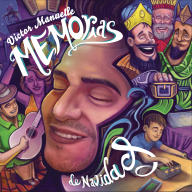Born Víctor Manuel Ruiz on September 27, 1968, in the Bronx, New York City, Manuelle was raised mainly in Isabela, Puerto Rico. A famous incident jump-started his professional singing career: Gilberto Santa Rosa was scheduled to perform at the graduation party of Manuelle's high school, and the salsa legend invited the teenage sonero to join him on-stage during the performance. Santa Rosa was so impressed by Manuelle's talent, he subsequently referred the young man to bandleader Don Perignon, who proceeded to hire him as a backup singer. Manuelle obtained priceless experience and industry contacts during his stint with Perignon, and he was ultimately awarded a solo recording contract with the Sony Tropical division of Sony Discos. Santa Rosa produced Manuelle's debut for the label, Justo a Tiempo... (1993), and a couple modest hits resulted ("Me Dará el Consentimiento," "Estás Tocando Fuego"). Manuelle's recording career was off to a respectable start, and his second album, Sólo Contigo, furthered his initial success. It racked up three charting singles ("Apiádate de Mí," "Voy a Prometerme," "Por Ejemplo"), the first of which climbed all the way to number three on the Latin Tropical/Salsa Airplay chart.
Victor Manuelle (1996), the singer's third album, was his breakthrough. Produced by the great Sergio George -- who was the go-to salsa hitmaker of the day, fresh off the mammoth success of Marc Anthony's Todo a Su Tiempo (1995) and India's Dicen Que Soy (1994) -- the self-titled album spun off one hit after another, six of them charting in total ("Pensamiento y Palabra," "Hay Que Poner el Alma," "Volveras," "Todo Quedo, Quedo," "Como una Estrella"), with two reaching number one ("Hay Que Poner el Alma," "Volveras"). Manuelle's follow-up album, A Pesar de Todo (1997), also produced by George along with co-producers Ramón Sánchez and Humberto Ramírez, kept the hit parade marching along unabated. Three of the album's four charting singles hit number one ("Así Es la Mujer," "Dile a Ella," "He Tratado" -- with "El Aguila" the one to fall short, reaching only number two). Victor Manuelle and Dicen Que Soy not only generated a bounty of hit singles but they also broke the singer into the Latin mainstream, as both albums made the Top Latin Albums chart, with the latter going Top Ten. Moreover, many of the singles spun off from these records made the Hot Latin Tracks chart, with a number of them going Top Ten.
Ramón Sánchez took over the production reins from George for Manuelle's next two albums, Ironías (1998) and Inconfundible (1999). Both were highly successful on a commercial basis, yet Ironías was especially so, including a wealth of hit singles ("Se Me Rompe el Alma," "Qué Habría Sido de Mí," "Al Igual Que Yo," "Qué Te Han Dicho"), the first two of which were chart-toppers. Inconfundible included a chart-topper of its own ("Pero Dile"), along with three further hits ("Si la Ves," "Como Quisiera Decirte," "Como Duele"). In addition to generating plenty of airplay, the two albums sold well: both topped the Tropical/Salsa album chart, with Ironías breaking the Top Five of the Top Latin Albums chart and Inconfundible making it all the way to number two. Nonetheless, commercial success only tells half of the story, for as popular as these albums were, Manuelle's music had begun to grow stale around this time. Sánchez's production may have been modeled after George's brash, street-edged sound, but it was no match. If anything, it was overdone, and indeed, Ironías and Inconfundible arguably sound over-produced in retrospect. Moreover, Manuelle himself didn't help matters, as the songs he sang became increasingly formulaic and predictably romantic in theme.
Manuelle broke away from the stagnation of his late-'90s work on Ironías and Inconfundible by aligning himself with some new collaborators. He worked with a new producer, José Lugo, whose long list of credits up to this point in time included steady work with Manuelle's mentor, Gilberto Santa Rosa, as well as rival Marc Anthony. Besides Lugo, Manuelle brought aboard Bobby Valentín, aka El Rey del Bajo, whose days as a storied bandleader dated back to the Fania All-Stars. With Lugo at the helm and Valentín providing inspiration, Manuelle fashioned his next album, Instinto y Deseo, as relatively straightforward salsa. The throwback style of the album seemed to be a response to critics, including fans turned critics, with whom Manuelle had lost favor. More than anything, though, it was simply a welcome change of course for the sonero. If the critics remained cautiously skeptical, consumers certainly took well to the album: Instinto y Deseo topped the Hot Latin Albums chart and spawned a pair of number one Tropical/Salsa Airplay singles, "Me Da Lo Mismo" and "Cómo Se Lo Explico al Corazón." Manuelle followed Instinto y Deseo with Le Preguntaba a la Luna, an even further old-fashioned album again produced by Lugo. Notably, four of the set's 11 songs were written by Manuelle, who previously had relied on professional songwriters, above all the prolific Omar Alfanno, who contributed one song to Le Preguntaba a la Luna, the chart-topping album opener "En Nombre de los Dos." Other hits from the album included "Poco Hombre" and "El Tonto Que No Te Olvidó," the latter of which also hit number one.
With his salsa credentials shored up in the eyes of many, Manuelle subsequently made a surprise left turn and unabashedly went for the so-called crossover. Hence, the name of his next album was Travesía ("Crossover" in English), and the producers with whom he worked were Emelio Estefan and the Gaitán Bros. (i.e., Alberto and Ricardo Gaitán), who between the two camps had worked with everyone from Gloria Estefan and Jon Secada to Ricky Martin and Thalía. These producers also served as songwriters, penning most of the album's songs. A lot of fans and critics were put off by the pop slant of the ballads that were sprinkled across the second half of the album, but on the other hand, Travesía featured a hefty serving of first-rate salsa on the first half, with a few hits standing out ("Lloré, Lloré," "Tengo Ganas," "Te Propongo"). The ballads sequenced toward the conclusion of the album were less engaging, though the pop version of "Tengo Ganas" was a sizable hit, climbing up to number 11 on the Hot Latin Tracks chart. The record itself sold exceptionally well, despite the criticism; it reached number one on the Top Latin Albums chart.
On the heels of Manuelle's "crossover," he performed a concert at Carnegie Hall in New York on November 8, 2004, that was subsequently released the following year on CD, produced by Estefan. The concert featured a moving rendition of the recently passed away Celia Cruz's signature song, "La Vida Es un Carnaval," which Manuelle had sung a cappella at her funeral in 2003. The song was released to radio as a single and became a modest hit. Late in the year, Sony released another live album featuring Manuelle, Dos Soneros, una Historia (2005), which showcased a poorly recorded, albeit milestone, concert also featuring Santa Rosa.
Manuelle executive produced his next studio album, Decisión Unámine (2006), himself. It was his first release under the Norte banner of Sony BMG, and it was another sharp turn of direction. Rather than going for the crossover like last time, Manuelle took a purist approach, embracing his salsa roots, and included numerous collaborations, including one with reggaeton superstar Don Omar, two with fellow salsero Eddie Palmieri, and one with Mexican sensation Yuridia. Lugo was back at the production helm and Valentín was again credited with arrangement, and together they, along with the other studio hands, brought an old-fashioned salsa style to the album that went surprisingly well with the occasional nods to contemporary styles like reggaeton. Decisión Unámine failed to reach number one on the Hot Latin Albums chart, climbing only to number six, but it was a success nonetheless, spinning off a few strong singles ("Nuestro Amor Se Ha Vuelto Ayer," "Maldita Suerte," "Nunca Había Llorado Así") and, above all, earning the praise of fans and critics. In fact, Decisión Unámine was perhaps Manuelle's most admired album since Instinto y Deseo, if not A Pesar de Todo. In the wake of the album's splash, Manuelle co-hosted the 2006 Latin Grammys and won a 2007 Premio Lo Nuestro award for Best Salsa Artist.
Soy and Yo Mismo, released in 2008 and 2009, continued Manuelle's string of tropical album chart-toppers, featuring a pair of singles, "Yo No Se Perdonarte" and "No Soy Quien." Still, his recording activity slowed slightly, resulting in two-year gaps between his albums -- 2011's Busco un Pueblo, 2013's Me Llamaré Tuyo, and 2015's Que Suenen los Tambores -- although they continued to place high in the Latin charts. Three years later, Manuelle released his 18th studio album, 25/7, which featured collaborations with Bad Bunny, Farruko, Juan Luis Guerra, and Gilberto Santa Rosa. In 2019, he issued Memorias de Navidad, which landed at number nine on the Top Latin Albums chart.
After two full years of inactivity due to the COVID-19 pandemic, Manuelle returned to recording with Lado A Lado B. The album was divided into halves, with the first devoted to showcasing the singer's love of modern Latin pop sounds, while the latter showcased his continued explorations into salsa gorda rhythms and more traditional tropical grooves. ~ Jason Birchmeier, Rovi


















